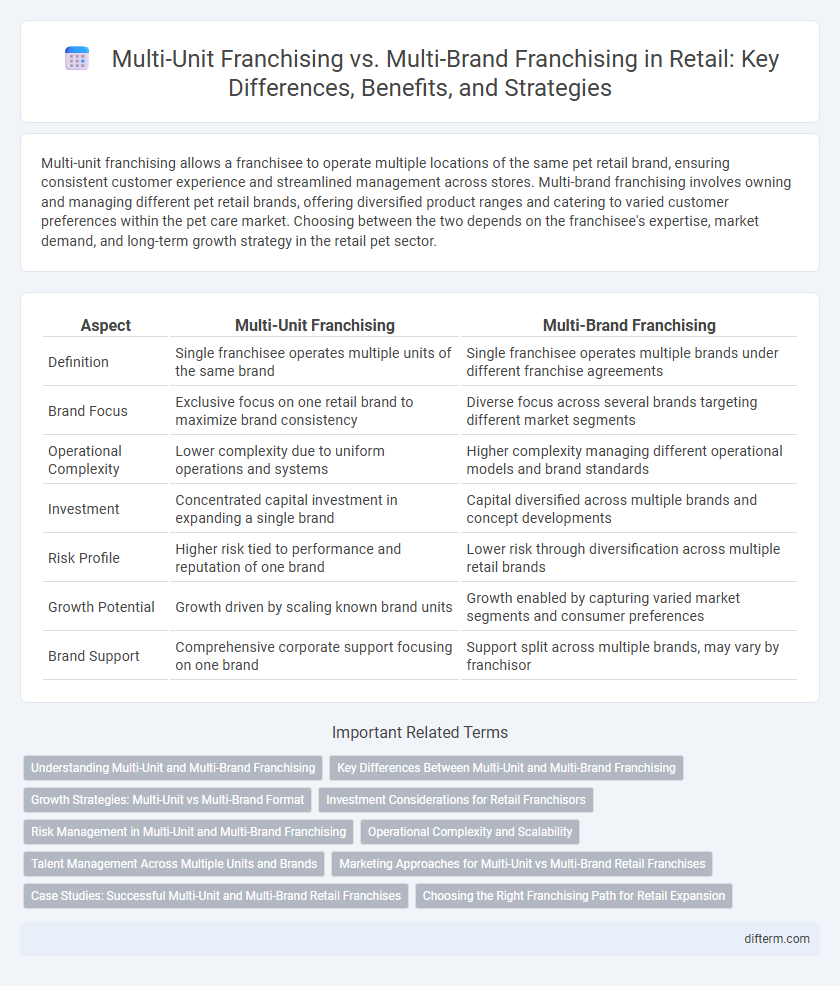Multi-unit franchising allows a franchisee to operate multiple locations of the same pet retail brand, ensuring consistent customer experience and streamlined management across stores. Multi-brand franchising involves owning and managing different pet retail brands, offering diversified product ranges and catering to varied customer preferences within the pet care market. Choosing between the two depends on the franchisee's expertise, market demand, and long-term growth strategy in the retail pet sector.
Table of Comparison
| Aspect | Multi-Unit Franchising | Multi-Brand Franchising |
|---|---|---|
| Definition | Single franchisee operates multiple units of the same brand | Single franchisee operates multiple brands under different franchise agreements |
| Brand Focus | Exclusive focus on one retail brand to maximize brand consistency | Diverse focus across several brands targeting different market segments |
| Operational Complexity | Lower complexity due to uniform operations and systems | Higher complexity managing different operational models and brand standards |
| Investment | Concentrated capital investment in expanding a single brand | Capital diversified across multiple brands and concept developments |
| Risk Profile | Higher risk tied to performance and reputation of one brand | Lower risk through diversification across multiple retail brands |
| Growth Potential | Growth driven by scaling known brand units | Growth enabled by capturing varied market segments and consumer preferences |
| Brand Support | Comprehensive corporate support focusing on one brand | Support split across multiple brands, may vary by franchisor |
Understanding Multi-Unit and Multi-Brand Franchising
Multi-unit franchising allows a franchisee to operate multiple locations of the same brand, leveraging streamlined operations and consistent brand identity to maximize market penetration and operational efficiency. Multi-brand franchising enables a business to manage various distinct brands, diversifying revenue streams and targeting different customer segments within the retail industry. Understanding the strategic benefits and challenges of both models is essential for optimizing franchise growth and achieving competitive advantage in diverse retail markets.
Key Differences Between Multi-Unit and Multi-Brand Franchising
Multi-unit franchising involves a single franchisee owning and operating multiple outlets of the same brand, optimizing brand consistency and streamlined operations across locations. Multi-brand franchising allows a franchisee to own and manage various brands under one portfolio, diversifying market risk and leveraging different customer segments. Key differences include the focus on brand uniformity in multi-unit franchising versus the broader market reach and varied product offerings in multi-brand franchising.
Growth Strategies: Multi-Unit vs Multi-Brand Format
Multi-unit franchising accelerates growth by allowing franchisees to operate multiple locations under a single brand, leveraging brand consistency and operational efficiencies. Multi-brand franchising diversifies market reach by managing various brands across different customer segments, reducing risk through brand portfolio diversification. Both strategies enhance scalability, but multi-unit focuses on deepening market penetration while multi-brand targets broadening consumer appeal.
Investment Considerations for Retail Franchisors
Investment considerations for retail franchisors differ significantly between multi-unit and multi-brand franchising models, with multi-unit franchising typically requiring concentrated capital allocation for expansion within a single brand. Multi-brand franchising demands diversified investment across varied marketing strategies, operational systems, and brand management, increasing complexity and capital outlay. Analyzing market trends, brand equity, and operational scalability is crucial for optimizing returns and managing risks in both franchising structures.
Risk Management in Multi-Unit and Multi-Brand Franchising
Risk management in multi-unit franchising involves mitigating operational risks across multiple locations under the same brand, ensuring consistent quality control and customer experience. In contrast, multi-brand franchising demands managing diverse brand identities and varied market strategies, increasing complexity in brand reputation and financial risk. Effective risk mitigation requires tailored approaches that address the unique challenges of scale, brand consistency, and market segmentation in each franchising model.
Operational Complexity and Scalability
Multi-unit franchising streamlines operational complexity by maintaining uniform processes across multiple locations under a single brand, facilitating easier management and consistent quality control. In contrast, multi-brand franchising introduces higher operational complexity due to diverse brand standards, marketing strategies, and product offerings that require specialized expertise and resource allocation. Scalability is often faster in multi-unit franchising because growth leverages established systems, whereas multi-brand franchising demands more adaptive frameworks to manage varied brand identities and customer segments effectively.
Talent Management Across Multiple Units and Brands
Talent management in multi-unit franchising emphasizes consistent training, standardized performance metrics, and streamlined employee progression across identical brand environments, facilitating operational uniformity and brand loyalty. Multi-brand franchising requires adaptable talent strategies that address diverse brand cultures, varied customer expectations, and specialized skill sets, promoting flexibility and innovation within the workforce. Effective talent acquisition, retention, and development tailored to either approach significantly impact franchise growth, employee engagement, and overall customer experience in the retail sector.
Marketing Approaches for Multi-Unit vs Multi-Brand Retail Franchises
Multi-unit franchising leverages a unified brand identity and centralized marketing strategies to maximize customer loyalty and brand recognition across locations, ensuring consistent messaging and economies of scale in advertising expenditures. Multi-brand franchising requires tailored marketing approaches for each brand, targeting distinct customer segments with customized campaigns to address varied market demands and preferences. Effective marketing for multi-brand franchises often involves differentiated digital marketing tactics, localized promotions, and distinct social media strategies to enhance each brand's unique value proposition.
Case Studies: Successful Multi-Unit and Multi-Brand Retail Franchises
Case studies reveal that multi-unit franchising enables faster market penetration by leveraging brand consistency across numerous locations, as seen in McDonald's expansion strategy. Conversely, multi-brand franchising demonstrates revenue diversification and broader customer reach, exemplified by Yum! Brands operating KFC, Pizza Hut, and Taco Bell under one corporate umbrella. Both models showcase scalable growth, but success hinges on operational excellence and strategic brand management tailored to distinct retail environments.
Choosing the Right Franchising Path for Retail Expansion
Multi-unit franchising allows retailers to expand rapidly by owning and operating multiple locations of the same brand, optimizing brand consistency and operational control. Multi-brand franchising offers diversification across different market segments, reducing risk by leveraging varied brand appeal and customer bases. Selecting the right franchising path depends on growth objectives, market conditions, and brand strength within the retail sector.
multi-unit franchising vs multi-brand franchising Infographic

 difterm.com
difterm.com